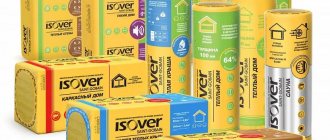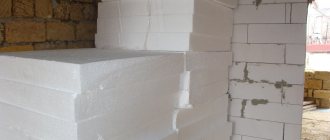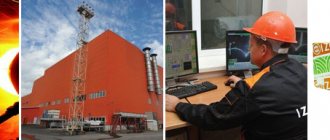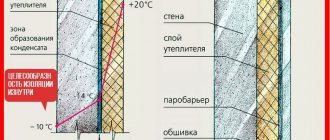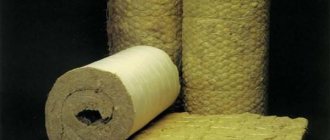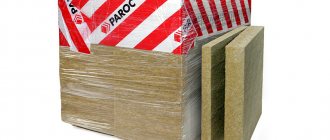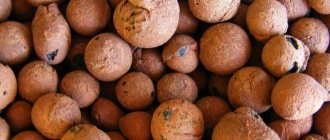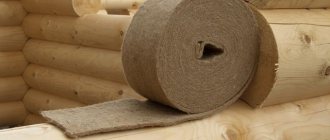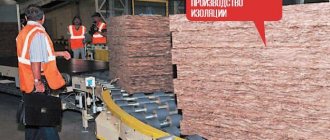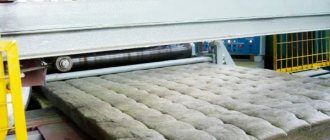In what cases are the dimensions of mineral wool taken into account?
When installing a thermal insulation system with the creation of a frame, pre-specified dimensions of mineral wool slabs, which are optimally suited for thermal protection in a given region, allow preparatory work to be carried out in advance, which makes it possible to reduce the time for creating thermal protection. This could be:
- for floor insulation, since insulation boards should be laid tightly between the joists;
- when insulating an attic space, since the size of the mineral wool affects the size of the cells or the pitch of the logs between which the insulation is tightly laid.
For exterior work, a frame can also be pre-created, into which slabs of heat-insulating material are then carefully placed between profiles or wooden slats.
There are no words, the high performance characteristics of slabs made of mineral raw materials, their elasticity and appropriate density, allow, if necessary, to cut off a piece in order to carefully place it in the right place. But don’t do this during the entire installation process. And no one needs extra joints.
Tips and tricks
Before buying a heat insulator, you need to check on the packaging whether it complies with Russian GOST standards. Minslabs are made in accordance with GOST 9573/96, and PPZh sheets in accordance with GOST 22950/95, and mats in accordance with GOST 21880/94.
You will also need to find out how much material is needed and in what direction the mineral wool fibers are located. If they are placed in a vertical position, then the heat insulator will become more reliable in conserving thermal energy; if they are placed chaotically, then the building material will become stronger, withstanding enormous stresses.
Slag wool and glass wool are characterized by low prices, but you need to think about what to buy beforehand. These insulation materials are not characterized by improved thermal insulation, and they have plenty of difficulties during installation.
The assortment of mineral wool thermal insulation and thermal insulation building materials on the construction market is very wide. Among them, there is an undisputed leader - stone wool. The demand for this thermal insulation material is very justified. Consumers are attracted by its undeniable advantages against the background of its low cost.
Types of insulation for ceilings and recommendations for selection
It is slightly ahead of polystyrene foam with its 0.041 W/m*⁰С, but it has problems with fire safety and toxic emissions.
Calculation of the required thickness
If you need to calculate the size of the insulating layer of the ceiling in a private house with a cold attic, use the formula δ = R*λ, where δ is the required thickness, R is the coefficient that determines the amount of heat transfer resistance, and λ is the thermal conductivity coefficient of the material. For the Moscow region, for example, R = 4.15 m2*⁰С/W. Knowing this, we calculate: 4.15x0.046 = 0.191 m. It turns out that mineral wool 20 cm thick or two layers of 10 cm each is suitable. For a multi-story concrete building it should be 2-3 times less.
Cost of insulation
The cost of ceiling thermal insulation may depend on a number of factors: density, thickness and number of layers, manufacturer, release form, installation method.
In order to somehow understand the flow of this data, let’s take the main characteristics of basalt wool. Traditionally, rolled thermal insulators are cheaper than slabs, since the manufacturer has lower costs for such production. Density determines how much material is spent on producing the same volume. For example, let’s compare the prices for ceiling insulation in a private house when using materials from different manufacturers with similar characteristics:
- Basswool: density – 40 kg/m3, cost – 1512 rub/m3, release form – slabs 1200x600 mm;
- Izol: density 40 kg/m3, cost – 1667 rub/m3, release form – slabs 1000x1600 mm;
- Isover: density 40 kg/m3, cost – 1288 rub/m3, release form – roll 7000x1220 mm.
The average price for ceiling insulation work can range from 160 to 600 rubles. per m2 depending on the number of layers and technology.
Laying, installation procedure
The first method is carried out at the stage of building a house and is preferable.
Ceiling insulation scheme from the outside:
- a sheathing is sewn onto the rafters or beams from below, onto which a vapor barrier or membrane is attached;
- Mineral wool is placed on top in the space between the beams;
- on top is a hydraulic barrier, after which the roof or floor is installed.
The second method - installation from the inside, is used when the ceiling is insulated with mineral wool with your own hands after completion of construction for the purpose of additional heat or sound insulation of the room.
The order of work in this case is as follows:
- a vapor barrier or membrane is sewn onto the ceiling;
- a wooden or aluminum frame is mounted taking into account the dimensions of the mineral wool;
- a thermal insulator is installed;
- a vapor barrier or membrane is again sewn underneath.
The inconvenience of the second method is that this insulating material does not retain its shape well and constantly crumbles, so insulating the ceiling in a wooden house yourself is quite problematic; at least one assistant is needed.
Recommendations:
- The cost of work can be reduced by using a vapor barrier instead of a membrane, but at the same time it is necessary to leave an air gap of 2-3 cm on top. In case of moisture penetration, this will avoid loss of insulating properties.
- It is much easier to insulate a ceiling from the outside than from the inside, so if you have the opportunity to do everything at once, do not put it off “for later”, then you will save much more resources.
- The density of mineral wool should be in the range from 40 to 75 kg/m3.
Results
Regardless of whether we are insulating a wooden or concrete ceiling, whether this happens in a residential or utility room, you must strictly follow the installation technologies described above. Violation can lead to moisture accumulation in supporting structures, which will significantly reduce service life.
Despite the widespread use of mineral insulation materials, there are also negative reviews about their use. He supposedly insulated the balcony or the floors, but there was still no heat. The reason may lie not only in violation of simple installation requirements (large cracks, cold bridges), but also in the fact that the thickness of the mineral wool was chosen incorrectly.
Mineral wool for external insulation. Advantages of external insulation
Insulate housing from the inside only in the most extreme cases. The justification may be the impossibility of insulating the walls due to the height, or the authorities’ ban on changing the appearance of the structure. Insulating walls outside with mineral wool often spoils the appearance of an apartment building. A separately insulated apartment stands out noticeably and disrupts the architecture of the city. But the main reason why the process is carried out outside is thermal engineering and physics. There is a term - “dew point”. If the insulation is located from the street, the dew point moves away from the internal walls. The house is warm and cozy, the walls remain dry.
Placement of the dew point, depending on the method of wall insulation.
Placing insulation inside will cause the walls to become damp. You will need to invest a lot of effort and money into a vapor barrier. No less important reasons:
- The usable area inside the apartment does not decrease. There is not a single case when a person wants less free space.
- The outer wall of the house is perfectly protected from all negative factors of nature.
- Good indoor ventilation.
- The appearance of the building is improved. You can hide gloomy gray walls, create a unique design and update the facade. This is very beneficial if you decide to sell your home.
Material
There are many options for wall insulation.
Modern technologies have filled this market segment. The most commonly used insulation is mineral wool. It is also called basalt, because it is made from natural raw materials - basalt. An additional component is silica. During the production process, the product is treated with water-repellent compounds. Everything is thought out in such a way that vapor permeability does not become worse. The building material is supplied to the client in the form of mats and slabs. A less convenient form of delivery is in rolls. The parameters of the final product may vary. The material itself has a fibrous structure. The fibers can be oriented in all sorts of ways. When positioned “parallel” we have conventional slabs. If the fibers are oriented perpendicularly, these are lamella slabs. Most often, the walls of buildings are insulated with cotton wool with a density of 75 to 145 kg/m3. A low-density slab can be attached directly to the wall. Low density allows you to fill all the unevenness in the wall (brick, concrete). It is customary to mount slabs with a density of 100 kg/m3 above the first layer. They allow you to get a smoother surface and make finishing work easier. To calculate the required quantity, you must proceed from the total area of the walls. From the resulting amount you need to subtract the sizes of windows and doors. A reserve of 5 to 10% is quite justified: you will spoil something, and the remainder will be useful on the farm.
Advantages of mineral wool
The material has significant advantages:
- Complete, high-quality filling of all voids. This cannot be achieved using polystyrene foam.
- There is no need to use a vapor barrier.
- The insulation technology is not particularly difficult.
- Fire resistance. The material does not burn and does not support combustion. It can withstand almost 6 thousand degrees of heat.
- Long service life if all installation requirements are met.
- Light weight. Mineral wool is easy to work with and does not place much load on the walls and foundation.
- Excellent thermal insulation.
The minimum total thickness of the insulation should be ten centimeters! The best option is to attach the insulation to a load-bearing wall, and then lay the brickwork using facing bricks. The insulation layer is located in the middle, is perfectly protected and “works” more efficiently. Mineral wool can be used to insulate a wooden house or a brick house. Sometimes buildings made of gas silicate blocks are finished with mineral wool. This action is justified if you live in the northern regions. But significant thickness is not required.
Mineral wool in slabs
Perhaps slabs are the most popular mineral wool product. They usually come in standard sizes. The slabs are always produced in a rectangular shape, their length varies in the range of 100-600 cm, and their width in the range of 20-180 cm. The thickness of the mineral wool in this case can be 1-25 cm. This range was achieved thanks to the production technology itself. In this case, the mineral wool fibers are well compressed and joined not with resins, but with synthetic glue. They are often impregnated with a hydrophobic compound or mineral oil, this protects them from moisture.
Thin slabs can only be used where they are not subject to significant loads. That is, for unused attic spaces, you can choose thinner slabs. They can also be used to insulate internal partitions, suspended ceilings and wooden floors. From a technical point of view. characteristics, mineral wool can be used for outdoor work. But in practice, it is easy to install only in houses built using frame technology or with three-layer brick walls.
The thickness of mineral wool for attic insulation should be at least 20, or even 25 cm. In general, such dense and thick slabs are highly durable, so they can be used not only for thermal insulation of the attic, but also where the loads will be even higher. For example, this could be insulation of floors built on the ground, insulation of a flat roof (mineral wool can be laid directly under roofing felt). In addition, such slabs can be used for thermal insulation of facades under plaster (that is, where the wet method is used).
Now let’s calculate the thickness for each city:
Coefficient Insulation thickness
- 0.035 - 150 mm;
- 0.04 - 180 mm;
- 0.044 - 200 mm;
- 0.045 - 205 mm;
- 0.046 - 210 mm;
- 0.047 - 215 mm;
- 0.05 - 225 mm.
With a thermal conductivity coefficient of 0.04, the calculation of the average thickness of the insulation layer for different cities in Russia will be as follows:
City Thermal Insulation Thickness (mm):
Table for calculating the average thickness of the insulation layer for different cities of Russia.
- Arkhangelsk 220;
- Astrakhan 160;
- Anadyr 290;
- Barnaul 210;
- Belgorod 170;
- Blagoveshchensk 230;
- Bryansk 190;
- Volgograd 160;
- Vologda 210;
- Voronezh 180;
- Vladimir 200;
- Vladivostok 190;
- Vladikavkaz 150;
- Grozny 150;
- Ekaterinburg 210;
- Ivanovo 200;
- Igarka 290;
- Irkutsk 220;
- Izhevsk 210;
- Yoshkar-Ola 210;
- Kazan 200;
- Kaliningrad 170;
- Kaluga 190;
- Kemerovo 220;
- Kirov 210;
- Kostroma 200;
- Krasnodar 140;
- Krasnoyarsk 210;
- Kurgan 210;
- Kursk 180;
- Kyzyl 240;
- Lipetsk 180;
- Magadan 250;
- Makhachkala 130;
- Moscow 190;
- Murmansk 220
- Nalchik 150
- Nizhny Novgorod 200;
- Novgorod 190;
- Novosibirsk 220;
- Omsk 210;
- Orenburg 190;
- Eagle 190;
- Penza 190;
- Perm 210;
- Petrozavodsk 210;
- Petropavlovsk-Kamchatsky 190;
- Pskov 190;
- Rostov-on-Don 160;
- Ryazan 190;
- Samara 200;
- St. Petersburg 190;
- Saransk 190;
- Saratov 180;
- Salekhard 280;
- Smolensk 190;
- Stavropol 150;
- Syktyvkar 220;
- Tambov 180;
- Tver 200;
- Tomsk 230;
- Tula 190;
- Tyumen 210;
- Ulyanovsk 190;
- Ulan-Ude 230;
- Ufa 200;
- Khabarovsk 220;
- Cheboksary 200;
- Chelyabinsk 200;
- Chita 240;
- Elista 160;
- Yuzhno-Sakhalinsk 210;
- Yakutsk 290;
- Yaroslavl 200.
Slab parameters depending on the area of use
Characteristics of slabs of different densities
Mineral wool is characterized by ease of installation and high performance - the dimensions and scope of application of the material depend on its hardness. Manufacturers produce the following modifications:
- Lightweight - with a density from 10 to 35 kg/m3. With their help, frame buildings can be insulated and protected from noise.
- Elastic - density from 35 to 120 kg/m3. The insulation is suitable for walls, its dimensions can be adjusted to the configuration of buildings. Mineral wool can withstand minor external loads.
- Hard – the density indicator is 120-180 kg/m3, which is suitable for working with ventilation systems, organizing thermal protection of baths and industrial premises.
The width of the insulation is determined by the climatic characteristics of the region. Buildings in the southern regions are decorated with sheets 120-180 mm wide, in the central - from 180 to 240 mm, in the northern - up to 360 mm.
The final parameters are determined by the type of insulated object.
Facade slabs
Facade products eliminate the cost of materials during construction. They are attached to a supporting frame, have good vapor permeability, do not shrink, and do not deform when exposed to temperature.
The dimensions of a standard cut of mineral wool supplied in slabs are 100x50x5 cm. For facades with a non-standard configuration, material 120x60x20 mm is suitable.
Roofing slabs
The material parameters depend on the region in which the roof is insulated. You can calculate the parameters using an online calculator or yourself, taking into account the standards for the climate zone, the layer-by-layer thickness of the structure, and the thermal conductivity of each layer. When choosing manufacturers, you will need to take into account the type of roofing structure.
The pitched roof is insulated with materials PAROS UNS 37 (610x1220x50 mm) and Extra (250x50 mm), Knauf (5500x1200x150 mm), Rocklight (1000/2000-500/600-50/100 mm), Techno (100x60x5/10 mm), Izover ( 1170x610x50 mm), Isovat (1000x600x50/100 mm).
For flat structures, the best options would be the products PAROS Rob (1200/1800x600/900/1200 mm), Monrock Max (2000x1200x50/200 mm), Tekhnoruf N (1200x600x100 mm).
For work in attics and attics with height differences and complex configurations, rolled glass wool with a density of 11-15 kg/m3 is suitable.
For walls
The suitable size of slab mineral wool is 120 cm in length and 100 cm in width. The thickness of the product is 2.5-5 cm. The material is used for external and internal work, insulation of rooms with high humidity, ventilated facades and sandwich panels.
Rigid modifications with a density of 150 kg/m3 are suitable for installation on metal or reinforced concrete floors. For fire protection purposes, a material with a density of 200 kg/m3 is optimal.
Mineral wool is laid on walls vertically and horizontally.
For floor
You can insulate the floor from cold air using products with dimensions of 600x800 and a density of 100-150 kg/m3. The length and width are adjusted to the coating parameters.
Advantages and disadvantages of ceiling insulation with mineral wool
This option is used in almost all buildings, providing a comfortable atmosphere in the premises. The ceiling can be insulated from the outside and inside. The cost of these works is almost the same. The quality of the result depends on the qualifications of the craftsman and the insulating material. You can do this work yourself, relying on the advice of professionals that can be found on the Internet. Many people insulate their home with mineral wool, since this material has almost no disadvantages and many advantages compared to other insulation materials. These include:
- affordable price;
- ease of use;
- the appearance of pests and various insects and rodents in the fabric is excluded;
- no toxicity;
- fire resistance;
- moisture resistance;
- rotting is not typical;
- protection against mold and other microorganisms;
- good noise insulation and heat insulation qualities;
- environmental friendliness, the material is not harmful to human health;
- vapor permeability, allowing the ceiling to “breathe” (keeps the room cool in summer, keeps warm in winter);
- resistance to mechanical manipulation.
There are also disadvantages, but they are not significant and do not in any way affect the quality of insulation. The main one is the reduction in thermal insulation data when compacting material in the packaging workshop. It can also lose its qualities when wet. Therefore, it must be protected from wet weather.
Mineral wool. Types, properties. (video)
The use of basalt insulation is a fairly popular method of insulating premises. The service life of mineral wool is very long, so it is used to insulate industrial buildings and residential buildings. Construction foil and stone wool is intended for various types of insulation. The volume of materials used depends on the area of the insulated room. Cotton wool is used to insulate walls, ceilings, floors and other surfaces. For each of them it is better to use cotton wool of a certain quality and composition.
Comments
0 Dima 07/10/2017 06:04 I’ll add that it is advisable to provide for humidity and take appropriate measures.
For example, when finishing the interior with plasterboard, you also need to secure polyethylene with a min of cotton wool. Quote
Update list of comments RSS feed of comments for this entry
Suitable sizes of mineral wool in slabs
The many advantages of mineral wool contribute to its widespread use in the construction process. To accurately calculate the required amount of material, you need to be informed about the size of the slabs. If when choosing thermal insulation materials you need to know the number of squares, then when choosing wool you need to pay attention to the dimensions of the slabs.
Standard slabs have the following dimensions: 1000 by 500 mm. In each specific case, you can select the appropriate thickness of the slabs. The number of slabs is determined by the size of the structure being finished.
Slab sizes:
- Izover Frame P-32 – 1170x610, while the thickness can vary from 40 to 150 mm.
- Izover Frame P-34 – 1170x565, while the thickness can vary from 40 to 200 mm.
- The rigid Izover plate is 1550x1180, with a minimum thickness of 30 mm.
You can calculate the required number of slabs in a hardware store, having previously measured the area of the room. You can calculate the number of mineral wool sheets in advance. Find out in advance how many sheets are in one package or pack. If the sheets do not fit, they can be carefully cut. Wadding trimmings can be used to insulate cracks and joints. The density of the sheets is selected depending on the required quality of thermal insulation.
Standard insulation sizes
The leader in the market of thermal insulation materials is. It produces plates, mats, rolls and cylinders. Varieties of mineral wool are used to insulate a specific type of structure. To insulate the frame structure, mineral wool is usually used, in which the thickness is 46-213 mm, the width ranges from 566 to 612 mm, and the length is 1175 mm.
For high-quality sound insulation of multilayer walls, mineral wool of the following sizes is used: thickness - from 51-101 to 205 mm, width - from 613 mm, length - from 1175 mm.
Flat roofs are usually insulated with wool, which has the following dimensions: thickness - from 55 to 175 mm. Width – from 1195 mm, length – from 1280 mm. All sizes of mineral wool can be found in special catalogs. The most common method of insulation outside and inside is laying mineral wool mats on frame structures.
Wool sizes:
- ISOVER M34 – 40 mm by 200 mm, 610 mm by 1220 mm. 3000 mm by 9000 mm;
- Frame-M37 – 42 mm by 203 mm, 610 mm by 1220 mm, 3000 mm by 22000 mm;
- ISOVER M40 – 50 mm by 200 mm, 610 mm by 1220 mm. 3000 mm by 9000 mm;
- Frame-M40 – 50 mm by 200 mm, 50 mm by 1200 mm, 7000 mm by 14000 mm.
To insulate the pipelines, it is necessary to use cylinders of mineral wool. Typically, for thermal insulation of roofs, facades, walls and other parts of a building, Knauf mineral wool is used, which is presented in the following variation: thickness - 55-155 mm, while its length and width can vary. The latter characteristics should be selected based on ease of use.
Example of insulation calculation
Table of wall thickness depending on the selected material and region of the country
The choice of thickness for a heat insulator must begin with the fact that the material is selected according to its intended purpose for a specific room and temperature zone. All zones that are used for calculations can be found in special reference books. Among the frequently used 4 are:
- 1 zone: from 3501 degree days;
- Zone 2: 3001-3501 degree days;
- Zone 3: 2501-3000 degree days;
- Zone 4: up to 2500 degree days.
The following calculation options can be cited as an example:
- The minimum permissible values for thermal resistance are represented by 4 zones of 2.8; 2.5; 2,2 and 2.
- Floors, coverings for unheated, unused attics: 4.95; 4.5; 3.9; 3.3.
- Cold basements, ground floors: 3.5; 3.3; 3; 2.5.
- Floors for unheated plinths and basements located at ground level: 2.8; 2.6; 2.2; 2.
- Floors for basements located below ground level: 3.7; 3.45; 3; 2.7.
- Balcony structures, display windows and panoramic windows, walls around them, translucent special facades, verandas, covered terraces: 0.6; 0.56; 0.55; 0.5.
- Front doors for apartment buildings, hallways for large public buildings: 0.44; 0.41; 0.39; 0.32.
- Entrance premises, corridors, hallways, halls for private low-rise buildings: 0.6; 0.56; 0.54; 0.45.
- Entrance halls and halls for premises located above the ground floor level: 0.25; 0.25; 0.25; 0.25.
Using this indicator, you can calculate the thickness of the heat insulator of any structure. For example, the walls of a house are built of 51 cm sand-lime brick. The insulation is made using 10 cm foam plastic boards. To determine whether the planned thickness of the insulation is suitable, you simply need to calculate the coefficient for the thermal resistance of the foam plastic and the wall, after which the obtained values are added and compared with those which are presented above.
For walls 51 cm, the following data is obtained:
- The thermal conductivity coefficient of sand-lime brick is 0.87.
- The thickness of the wall 51 must be divided by 0.87 to obtain the thermal resistance of the brick equal to 0.58.
- With polystyrene foam they do things differently. Its thickness is divided by the thermal conductivity coefficient of this material 0.043, the result is 2.32.
- Now we need to add up the obtained values, the result is 2.88. This indicator must be compared with those given above. If the data obtained for external walls made of sand-lime brick coincide with those required for a specific region (climatic zone), then 10 cm of foam plastic will be quite sufficient.
It must be remembered that if the insulation is used for colder areas, then its thickness should be 12-14 cm to create comfortable living conditions in the house.
To choose the right thermal insulation material, you need to carefully determine its parameters. The influence is exerted by what climatic zone the house is being built in, what material its walls are made of, and for what part of the structure the heat insulator is used
It is important to immediately pay attention to the features of using a certain type of insulation. Usually mineral wool or polystyrene foam is purchased, but their characteristics are different, so you need to calculate separately for each material
Insulation thickness for attic roof
A well-insulated roof is the best way to keep your home warm and save on heating costs. This is also an opportunity to expand the usable area of the house and create a residential attic under the roof, the heating of which will not cost large sums. In matters of roof insulation, numerous nuances associated with insulation and its installation under the roof are of great importance.
Not only the microclimate under the roof, but the integrity and safety of all roofing elements depends on the correctly selected material and its proper installation, observing the order of all layers of the roofing pie. Today we’ll look at what thickness of insulation is needed for a roof and how to calculate it yourself.
Insulation materials
Before you start calculating the thickness of the insulation, it is important to decide on its type. The main criteria by which thermal insulation for an attic roof is selected are:
- Low weight to prevent heavy load on the rafter system,
- Properties that do not absorb liquids
- High fire safety, which is especially important when venting through the roof of a chimney,
- The material should not shrink during use.
Let's take a closer look at the three most common types of roof insulation - glass wool, polystyrene foam and stone wool.
Recently, polystyrene foam has become popular as an insulating material. Despite its good heat-retaining properties, it is not reliable, fire safe or environmentally friendly.
What determines the thickness of the insulation?
The thickness of the roof insulation depends on a number of factors that must be taken into account at the roof design stage:
- Type of material and the value of its thermal conductivity. The concept of specific thermal conductivity implies the amount of heat leakage through a certain unit of material in 1 hour, if the temperature difference under the roof and outside is 1 degree. All three of the above insulation materials can withstand the standard value of 0.04 W/(m*°C),
- Climatic conditions, to determine which the minimum values of temperature and humidity of the surrounding air are taken. The higher these values, the thicker the material should be,
- The presence of a hydro- and vapor barrier layer. Waterproofing prevents cold air from entering directly onto the insulation and replacing the warm air accumulated in the material. Expanded polystyrene does not have this feature and can be used without additional wind protection. The entry of water vapor into the insulation in the absence of a vapor barrier will also negatively affect the properties of the material.
We recommend: Furniture wax: types, application, how to use correctly
Calculate the thickness of the insulation
The thickness of the roof insulation is calculated using a special formula:
- And the insulation. – required insulation thickness in m,
- R – heat transfer resistance in sq.m*°C/W,
- λth is the value of the thermal conductivity of the insulation in W/(m*°C).
The value of R must be looked at in a specialized table of heat transfer resistance data; for each region the value will be different. Information about the thermal conductivity value of the material is contained on its packaging. For the three types of materials given in the article, this value averages 0.04 W/(m*°C).
It is logical that in more northern regions the thickness of the insulation will be significantly greater than in the southern ones. Let's give an example of how thick basalt wool will be in different cities of Russia:
- the thickness of basalt wool in Moscow or St. Petersburg will be around 20 cm,
- for Izhevsk or Omsk this value will be 25 cm,
- Northern cities such as Vorkuta or Chita will need a 30 cm layer of basalt wool,
- More northern areas require the use of a 35 cm layer.
Calculating the amount of insulation on the roof
To calculate the required amount of material, it is important to remember the rules for its installation. Proper insulation of the roof implies that the insulation is laid between the rafters at cross-section, that is, the width of the material is 1.5-2 cm wider than the pitch of the rafters
It is much easier to decide in advance on the brand of insulation and its dimensions at the time of design and construction of roof trusses. The standard dimensions of the slab are 117*61*10 cm, which is especially convenient with a standard rafter pitch of 60 cm. In this case, there is no need to trim or join the slabs.
To calculate the required number of slabs, it is necessary to determine how many will lie along and across. To do this, it is necessary to take into account the length of the roof slope and the number of spaces between the rafters.
For example, we have a roof with 6 rafter intervals of 60 cm each. That is, one sheet of insulation will lie in each gap. In this case, the length of the slope of a gable symmetrical roof is 5 meters.
Let's calculate how many slabs are needed in one row:
Why is thermal insulation needed?
Many people do not fully understand how the thickness of insulation affects the durability and technical characteristics of a structure. In simple terms, thermal insulation allows you to save on utility bills, because heat loss is reduced by almost a third, and in some cases by half.
Another important side effect of thermal insulation is sound insulation.
This is especially important for apartment buildings in urban areas, where sounds from the street can cause unnecessary discomfort. Panel houses also have extremely low sound insulation
If we are talking about personal construction with your own hands, for example, your own mansion or a country home, then thermal insulation materials make it possible to reduce construction costs by replacing materials for building walls.
So, using thick polystyrene or mineral wool slabs (within 10 cm wide), it is possible to replace brick walls with them. The load on these walls must be small, so this method is suitable for one-story buildings, building verandas or houses for guests.
Mineral wool for wall insulation and its sizes: 11 options
When choosing insulation, carefully study the characteristics of mineral wool so that it meets all the requirements. You can insulate the house yourself. This can be done easily and simply if you decide on the type of thermal insulation material and become familiar with the nuances for its installation. When choosing insulation, special attention should be paid to the properties of the material. Mineral wool dimensions are an important issue that needs to be resolved before laying the material. Mineral wool of different lengths, thicknesses and widths is suitable for a specific type of work.
Some characteristics of insulation
Foam is widely used for insulating walls, floors and ceilings. In the attic, the functions of walls and ceiling are performed by the roof of the building. It is not recommended to use polystyrene foam to insulate it for the following reasons:
Stages of attic roof insulation.
- all roof elements, including insulation material, must be well ventilated;
- the insulation must allow air and moisture vapor to pass through well.
According to the laws of physics, warm air rises from bottom to top. Polystyrene foam does not allow moisture contained in warm air to pass through at all. This will lead to the formation of condensation from inside the room. As a result, within 1-3 years the parts of the rafter structure will become damp, trickles of water will begin to flow through the insulation material, mold will appear, and the wooden parts of the roof will begin to rot.
Very common materials are mineral wool and glass wool. They have low cost and excellent resistance to high temperatures. When working with glass wool, it is necessary to take special protective measures, since the smallest particles of glass when they come into contact with open areas of the skin cause severe irritation and significant pain. You can only work in protective clothing, gloves and goggles. The thickness of the thermal insulation layer made of mineral wool or glass wool is selected at the rate of 15-30 cm. This depends on the climatic zone in which the house is located.
Attic roof insulation elements: 1 – mineral wool; 2 – vapor and wind barrier (membrane); 3 – waterproofing; 4 – air flows; 5 – rafter; 6 – roof; 7 – attic cladding.
The negative aspects of this insulating material include its slight deformation and hygroscopicity, which can lead to a decrease in thermal insulation properties. Glass wool is also not an environmentally friendly material. Therefore, it is preferable to use mineral wool. You need to purchase mineral wool based on a density of 40-45 kg per cubic meter. This is optimal. Mineral wool is a material that provides:
- environmental safety;
- non-flammability;
- good sound insulation;
- resistance to moisture and temperature changes;
- frost resistance;
- protection from rodents and other pests;
- resistance to fungus and mold;
- quick and easy installation.
You can use felt, hemp, sawdust, and reed slabs. But all these materials require preliminary antiseptic and fire retardant treatment. These operations significantly increase the life of thermal protection equipment.
Sandwich panels are more expensive than mineral wool, but guarantee the quality and durability of the insulation. They consist of several layers: vapor barrier, insulation, waterproofing, decorative.
Foam glass slabs are a relatively new and expensive insulation material. Has high strength. The material is quite elastic and resistant to various mechanical influences. Ideal for thermal protection when using soft roofing.
Advantages of fiber insulation
Mineral wool boards are characterized
:
- low specific gravity - insulation with this material will not overload the structure;
- high strength (this indicator depends on the density of the slab);
- fire resistance;
- biostability (the material is resistant to decay, unattractive to pests and rodents);
- durability (service life, provided proper installation, exceeds 50 years).
Comparison of thicknesses of materials for thermal insulation
High technical characteristics make the material a market leader in thermal insulation
.
Thermal conductivity
Due to its fibrous structure, slab thermal insulation made of mineral wool provides good protection against heat leakage. Thermal conductivity indicators depend on the type and purpose of the slabs - they are in the range of 0.036-0.042 W/(m•K) at temperatures from 10°C to 25°C according to GOST 4640-2011.
Fire resistance
Mineral wool is a material with a high degree of fire resistance - such insulation does not ignite from random sparks and does not contribute to the spread of fire. Fiber boards withstand contact with surfaces heated to +400°C and air heated to 750°C.
Non-combustible slabs made of basalt fiber can withstand contact with an open flame (1000°C) for two hours, provided that the material is made without the use of fillers made from flammable synthetic substances.
Density
The higher the density of the block, the stiffer it is and the better it can withstand deformation stresses under load. The following types of mineral wool slabs differ:
:
- soft slab (40-55 kg/m3, grade PM-40 and PM-50);
- semi-rigid slab (60-90 kg/m3, grade PP-60, PP-70, PP-80);
- rigid slabs (100-150 kg/m3, grade PZh-100, PZh-120, PZh-140);
- slabs of increased rigidity (160-210 kg/m3, grade PPZh-160, PPZh-180, PPZh-200);
- hard slab (220-300 kg/m3, grade PT-220, PT-250, PT-300).
Laying slabs with your own hands in the attic
Waterproof
Mineral wool slabs are prone to moisture accumulation. The strength and other properties of the fiber are not affected, but the replacement of air with moisture in the structure of the material leads to a sharp increase in the thermal conductivity coefficient, that is, a deterioration in performance properties. The use of certain fillers allows the material to be hydrophobized. According to GOST, the average water resistance level of insulation should be 4-7 pH.
Vapor permeability
Mineral wool is characterized by the highest vapor permeability in comparison with heat insulators made from other materials. The indicator is 480*10-6 g/(m*hour*Pa). In insulating structures where an impenetrable vapor barrier is not provided (for example, external insulation of walls under plaster) or a gas-permeable membrane is used, insulation with mineral wool makes it possible to maintain gas exchange through the structure, which ensures a favorable microclimate in the room.
Using a vapor barrier to protect against moisture
Comparative characteristics of the service life of insulation materials table
There are many types of insulation, but today we will take a closer look at the most budget-friendly and reliable options. These include:
- Mineral wool.
- Basal wool.
- Styrofoam.
| Name | Life time |
| Mineral wool | 25-40 years |
| Basal wool | 40-50 years |
| Expanded polystyrene | 30-50 years |
| Polyurethane foam | 20-50 years |
| Foam glass | 80-100 years |
The first type is called stone. It has a fairly high level of quality, as it is made from basalt stone. Its cost is much higher, but both the quality and the period of suitability meet expectations. According to statistics, mineral wool is used most often in construction. Duration of operation is about 50 years. But this figure is still disputed, and it has several nuances. At the moment there are two types of mineral wool.
The second is slag. This means that water practically cannot penetrate into it, and the material itself is quite dense. Accordingly, it is made from slag from the metallurgical industry. It is significantly inferior to the previous one in price, quality, and service life. In addition, it is not resistant to sudden temperature changes and may become deformed after a certain time. But despite this, it is often used as the best option if the construction is temporary or less significant.
It is worth noting that this substance has two important advantages:
Non-flammability. You don’t have to worry that the material is not susceptible to fire from metal tiles, which can heat up to high levels in extreme heat. And also other effects of high temperatures will not pose a threat to the insulation, and therefore to you.
Vapor permeability
Izover has the ability to “breathe,” which is also important. The material easily passes all vapors through itself, but at the same time they do not accumulate inside
This property makes mineral wool environmentally friendly, and in combination with thermal insulation it is a huge plus. In addition, no additional treatment is required for condensate.
Basal cotton wool is not inferior in the duration of the action of the previous substance. Manufacturers provide a warranty of over 50 years. A very long time ago, construction began to use insulation made from fibrous material. But the peak of its exploitation has occurred in the last couple of decades. This happened due to the intensive construction of country houses, as well as increased heating prices. This is where the material is very popular.
Over time, the quality of basal wool has improved significantly. Now it is an environmentally friendly and safe product. The main advantages include several aspects:
- Fire safety. The material can easily withstand high temperatures without losing its properties.
- Low hydrophobicity. The substance repels moisture, which significantly increases the service life of the insulation.
- Compressibility. Basal wool is very resistant and does not undergo deformation.
- Chemical resistance. Rotting, fungus, rodents, mold and harmful microorganisms will no longer become a threat to your home.
Despite the coincidence, the materials are of excellent quality, do not deform or crumble. The substances are used everywhere and have many positive reviews. With such insulation, your walls can last for more than 100 years.
Brief characteristics of the material
Insulation for walls, ceilings and floors under the general name mineral wool is several different types - stone, basalt, glass wool. They all have common positive characteristics, including:
- Naturalness. Regardless of the type, such insulation is made from environmentally friendly materials.
- Low thermal conductivity coefficient.
- Possibility of operation in different temperature ranges.
- Fire safety - the insulation does not burn, but smolders.
- Soundproofing properties.
Important! Modifications of stone wool sizes include rolls, slabs, and cylinders. They differ in density, footage and rigidity.
Parameters for insulation
Table with technical characteristics of the main insulation materials.
Insulation materials are selected based not only on thickness, but also on other indicators. What thickness to take depends on the following:
- climatic region for the construction site;
- main wall material;
- purpose of the room, its level above the ground;
- manufacturing material.
Manufacturers offer a variety of options. Many people claim that aerated concrete or expanded clay concrete is an excellent option for building a warm house; here you can save on insulation. But is this really so? It is necessary to compare thermal conductivity coefficients. In order for the thickness to be selected correctly, it is necessary to take into account that all insulation materials differ in their characteristics, their thermal conductivity indicators will be different.
Calculation table for insulation depending on wall material.
As comparative data you can take:
- Expanded polystyrene thermal insulators with a thermal conductivity coefficient of 0.039 W/m*°C with a thickness of 0.12 m.
- Mineral wool (basalt wool, stone) with data of 0.041 W/m*°C and 0.13 m.
- Reinforced concrete walls with data of 1.7 W/m*°C and 5.33 m.
- Solid sand-lime brick with data of 0.76 W/m*°C and 2.38 m.
- Hollow (holey) brick with data of 0.5 W/m*°C and 1.57 m.
- Glued laminated timber with values of 0.16 W/m*°C and 0.5 m.
- Expanded clay concrete (warm concrete) with values of 0.47 W/m*°C and 1.48 m.
- Gas silicate blocks with data of 0.15 W/m*°C and 0.47 m.
- Foam concrete blocks with a thermal conductivity coefficient of 0.3 W/m*°C at 0.94 m.
- Slag concrete with data of 0.6 W/m*°C and 1.8 m.
Based on the listed data, you can see that the thickness of the wall to ensure a normal and comfortable microclimate is from one and a half meters. But that's too much. It is best to make the wall thinner, but use a layer of mineral wool or expanded polystyrene with a thickness of only 12-13 cm. This will be much more economical.
Advantages of minislabs over other insulation materials
Let's start with the most important parameter for mineral insulation - thermal insulation properties. According to verified technical data, the ministove retains heat no worse than natural sheep wool, for which it is valued. The secret of any cotton wool is that small air bubbles get stuck between its small fibers, and air, as you know, is the worst conductor of heat.
Thanks to this structure, cotton wool easily stops the heat flow and prevents it from leaving the living room or attic. This property is determined by the thermal conductivity coefficient λd, and the smaller it is, the better the material retains heat. Thus, high-quality mineral wool has a thermal conductivity coefficient of no more than 0.032 W/(m•K).
Mineral boards have excellent thermal insulation and acoustic properties, as well as high fire resistance. When heated, it does not emit toxic or harmful substances, and therefore is excellent as protection or fire insulation.
Indeed, according to the European seven-point scale, mineral wool has fire resistance A1 and A2, this is the same NG parameter in domestic standards, which means “non-flammable”. During a fire, mineral fibers emit almost no smoke, which is also important, and do not crack or melt:
In terms of fire safety, mineral wool varies depending on the raw materials used:
And now – about the shortcomings. Mineral wool is a vapor-permeable material, and water vapor passes between its fibers without being absorbed into them. Therefore, the main thing that needs to be achieved during the installation process is to allow these vapors to escape so that they do not accumulate inside the slabs: wet mineral wool will not dry out and will have high thermal conductivity. This is the main disadvantage of this insulation, because the same polystyrene foam or polystyrene foam is almost 100% vapor-tight.
Thickness of mineral wool for ceiling insulation
The choice of insulation thickness depends on the material from which the ceiling is made and what type of insulation is planned to be produced.
- When installing insulation on concrete ceilings with high thermal conductivity, it is better to use mineral wool 10-15 cm thick
- If the house has a heated attic space, then in this case it is allowed to use insulation with a thickness of 60-80 mm
- Ceilings in houses with a pitched roof structure made of a material with high thermal conductivity must be insulated with mineral wool with a thickness of up to 30 cm
Moreover, these parameters are not fixed, since the choice of mineral wool thickness is influenced by the structure of the material, as well as its density. With a density of 50 kg/m3, you should choose insulation with a greater thickness. If the density of the material is 100-150 kg/m3, then the thickness can be chosen half as much.
Cost of ceiling insulation with mineral wool
Prices for ceiling insulation with mineral wool depend on several parameters:
- Type of insulation – roll or in slabs. The latter usually costs more
- Thickness of mineral wool - the higher this indicator, the more expensive the insulation will be
- Density of the material – mineral wool with a higher density will be more expensive
You can minimize costs by insulating the ceiling yourself, especially since this does not require special experience or professionalism.
In conclusion, we can conclude that insulating the ceiling with mineral wool is one of the most affordable in terms of labor intensity and budgetary costs, a method that is not without high efficiency.
Step-by-step instructions for insulating the ceiling with mineral wool on video
To get the maximum understanding of the process of insulating a ceiling with this material, it is recommended that you become familiar with the intricacies of choosing insulation and the procedure for installing it visually. This can be done by watching a video showing all the stages of insulation.
Labeling: what to look for?
Let's start with the fact that it is important to learn to understand the markings on the packaging of mineral slabs. Along the way, you will learn about what parameters of such insulation are considered important and what you should pay attention to.
If you prefer well-known manufacturers, on the packaging of their products you will find information such as:
- Product name, brand, year of cotton wool production and even shift number during production.
- Fire resistance class and calculation of thermal resistance - thermal conductivity coefficient (not always).
- The amount of mineral wool itself in the package, marking code, thickness and, if necessary, type of cladding.
Also additionally, if desired, indicate:
- dynamic stiffness (sdi) and dimensional stability at a certain temperature ds(t+);
- compressibility (cpi) and compressive creep cc(i1/i2/y)σχ;
- concentrated load at a deformation of 5 mm (pl(5)i);
- water absorption during long-term immersion in water (wl(p)) in compressibility;
- average (awi) and actual (api) sound absorption coefficient and air permeation resistance (afi).
What does this amount of information provide? The fact is that thanks to the ability to read the markings, you will know for sure whether the mini-slab is rigid enough to be used on a flat roof or in enclosing structures, whether it is suitable for the attic, whether it will fit between the rafters or will fall out, and everything is fine. this style.
We recommend: Ventilation and climate control equipment
And modern mineral wool is supplied in the form of slabs, granules and rolls, of a wide variety of types and densities:
Let's calculate the required amount of insulation
It is useful to consult a professional on any issues. For example, which wool is better for a particular object - stone wool, one that uses basalt rocks, the so-called basalt wool, or another.
Will you need foil wool, what mineral wool materials will be needed at all, and is it possible to optimize costs.
For example, let’s calculate the required amount of insulation for the roof.
Stage one:
- calculate the roof area;
- we add the area of the attic walls and partitions;
- We add 3% to the amount received.
Stage two. We choose the insulation whose roll area most closely matches the insulation area. We consider the material both sheet, and in rolls, and in mats.
Stage three. We divide the roof area by the area of the insulation squares and multiply the unplanned number of layers. The amount received will determine how many sheets, rolls to buy, and how much slab material will be required in pieces.
In order not to waste money on cutting insulation, carefully calculate the dimensions of the room, carefully analyze everything that is written on the packaging of this or that insulation. However, even if the mini-plate or roll tape has been trimmed, there is nothing to worry about. The waste will be useful for insulating adjacent buildings.
Mineral wool is considered almost the best insulation on the country's construction market. The sizes of different brands of these products are almost the same.
The dimensions are dictated by building codes; this standard approach largely optimizes the construction process.
When choosing insulation, it is important to take into account technical characteristics, professional advice on the purpose of a particular material, length, width, thickness and other important indicators.
A significant characteristic is density. Typically it is 11-350 kg/m kV. The highest density wool is used for internal partitions and has dimensions similar to other types of insulation.
Watch the video that explains the nuances of calculating and laying insulation:
How does the purpose of mineral wool affect its size?
Insulation is necessary for any building in order to:
- reduce heat loss in winter;
- protect from overheating in summer;
- preserve elements of the building’s supporting structure from the effects of negative environmental factors;
- increase the service life of the structure.
These tasks are entirely within the capabilities of inorganic insulation materials. Of the large list of materials of this kind, mineral wool is in particular demand. Mineral wool has been successfully used in construction for a long time.
Related article: How to attach a cable duct to a concrete wall
By giving preference to this type of insulation, the consumer receives the following advantages:
- thermal conductivity index 0.035 W/μ, one of the best;
- high-quality dielectric properties;
- high levels of vapor permeability;
- best fire resistance parameters;
- low hygroscopicity;
- high resistance to aggressive environments.
This material can be used to insulate walls, both inside and outside. It is used for roofs, attics and basements, and internal partitions. Its dimensions have the same standards as the distances between the guides where the mineral wool is laid. If violations of standards occur in construction, there is also a need to adjust the size of the insulation.
Mineral wool differences
As we have already said, there are three types of mineral wool insulation. Each of them is made from different raw materials and has its own properties.
Glass wool
A material consisting of molten glass cullet, dolomite, sand, soda or limestone.
Advantages:
- Breathability.
- Fire resistance.
- Elasticity, vibration resistance.
- Withstands low temperatures.
- Lower cost than other mineral wool.
Minuses:
- Short shelf life - 5-10 years.
- Shrinkage 80%.
- Strongly absorbs moisture.
- If it comes into contact with the skin, it causes itching or even an allergic reaction.
As for the scope of application, it is usually mineral wool for insulating walls inside the house.
Slag
Produced from metallurgical waste. Inferior in characteristics to other types of insulation.
- Does not provide adequate sound insulation.
- Does not withstand strong heat. It does not burn, but it sinteres and loses its thermal insulation qualities.
- Does not tolerate temperature changes.
- Protective clothing and a respirator for installation are also required.
- It is impossible to insulate damp rooms with metal fasteners, since under the influence of moist air, slag will promote corrosion.
- High hygroscopicity.
Related article: How to fix a plinth to a concrete wall
Plus, such a layer in the wall does not attract rodents and insects. Most often used on dry surfaces of temporary buildings or non-residential buildings.
Stone
The most expensive material. It is usually chosen for exterior work in private houses, including frame wooden houses. Rocks are used in production. Thanks to this, the final product has many advantages:
- High density and therefore strength.
- Fire resistance. Does not ignite at any temperature.
- Minimum shrinkage (5%).
- Long service life (up to 50 years).
- Provides excellent sound insulation.
- Almost does not break during operation, which happens with other types of products.
- Vapor permeability. The fibers repel moisture.
The downside is the high cost. Despite all the advantages, it is not always rational to insulate with these slabs.
Application
Insulation is produced in rolls or slabs. For example, rolls are best for roof insulation, slabs are good for walls.
There are also mats that are necessary for insulating the floor.
Stone wool is often produced in the form of granules, as well as in the form of cords and bundles. These forms of packaging are used in industrial construction.
To effectively insulate a house, the following thickness of mineral wool is used:
- outer wall – 100mm;
- ceiling, attic – 150 mm;
- roof and attic – 300 mm.
The width of mineral wool in rolls and slabs is the same - from 565 cm to 620 cm, length - from 1117 cm to 1380 cm. The data is given using the example of Isover mineral wool.
Another similar insulation, for example Ursa, is also universal in use. Ursa is produced in slabs and mats with a thickness from 30mm to 100mm, length from 1250 to 10000mm, width 610mm -1200mm.
As you can see, the differences in dimensions between different brands are insignificant. The price is also about the same.
And yet, specialists at different sites use different brands of mineral wool insulation.
No matter how similar different types of insulation are in their technical and operational characteristics, sizes and other indicators, advice from a professional on their use will be extremely useful!
